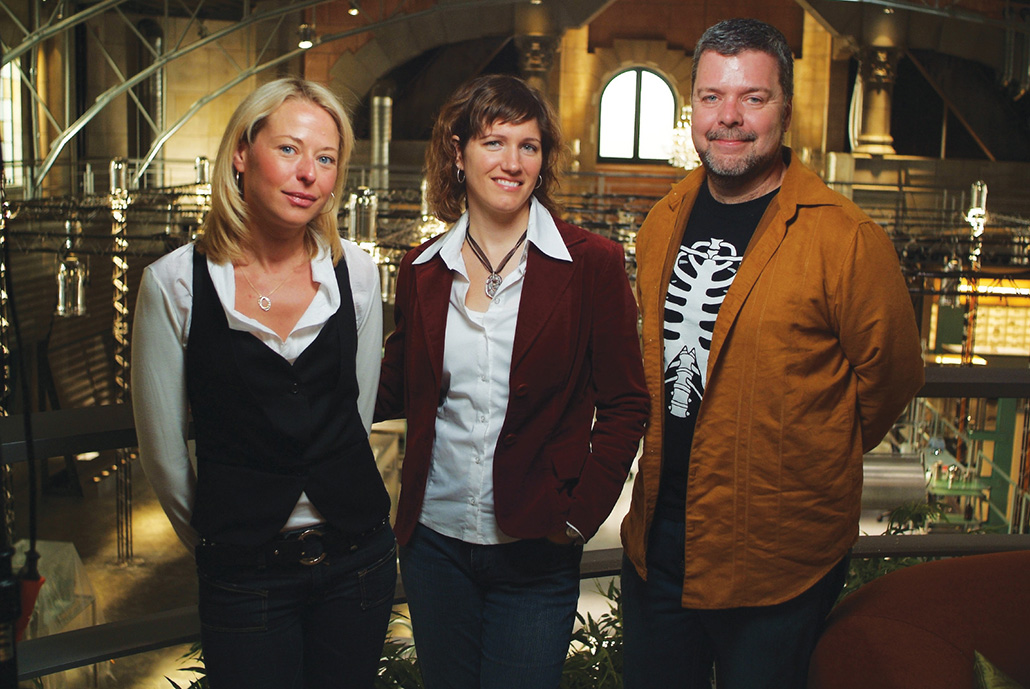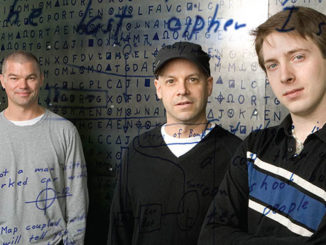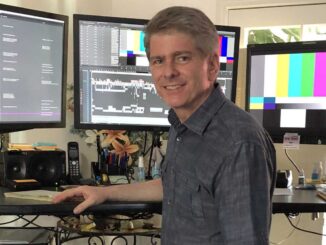
by Laura Almo • photos by Deverill Weekes
Three years ago, Andrea Folprecht was an assistant editor on the Fox television show Bones, starring Emily Deschanel as forensic anthropologist Temperance Brennan. When Harry B. Miller III, A.C.E., one of the show’s three editors, left to work on a pilot, Folprecht was promoted to editor and given an opportunity to edit one of the last episodes of the first season. She did a superb job.
At the end of Season Two, another editor, Tom Moore, also departed the show to cut a pilot. Richard Currie, an assistant editor since the first season, was also upgraded to editor and allowed to take a shot at the season finale. Like with Folprecht, everyone was ecstatic with the way the episode turned out.
Proving that good things come in threes, early on in the third season, editor Casey O. Rohrs moved on to work on a feature and another assistant, Kimberly Ettinger, was asked to tie up loose ends on Episode One. She was then bumped up to editor and given an entire episode to edit.
Although these occurrences are far from commonplace, they are testament to the talent of these assistants-turned-editors. Perhaps their story will give hope to assistant editors and inspiration to producers working on other shows.
It is a well-known fact that it can be quite difficult to move up from assistant to editor. It’s also a risk that many producers are hesitant to take. It’s more likely that producers will bring in an established editor with a track record rather than take a chance on an assistant who has yet to prove him or herself as an editor. But Stephen Nathan, Bones’ executive producer in charge of post-production, sees it differently. “It didn’t cross my mind to ignore the assistant editors and go to other people,” he says candidly. “My instinct was to try to use them first. I think most people’s instinct is to say, ‘Oh, let’s call up another guy who’s been working for 25 years.’ That could be great, but I didn’t understand why people who were in the family to begin with should be overlooked just because they hadn’t done it before. Everyone in the business always has to remember their first shot.”

With the recommendation, support and oversight of the Bones editors, each of the assistants was upgraded to editor to cut an episode––with the proviso that if it didn’t work out, she or he would have to return to the assistant position. Each accepted the conditions and welcomed the opportunity.
The key, explains Currie, is that all along, the editors mentored the assistants and, in today’s world of post-production, that is no small feat. The assistant’s job is vastly different from the editor’s, and these days, the technical aspects are so much more demanding.
“I worked on a lot of feature films as an assistant editor and I was enjoying it, but I wasn’t getting an opportunity to learn how to cut,” he reflects. “I decided to try to get into television because I thought I had more of an opportunity to move up. My first TV experience was doing Judging Amy as an assistant editor. I have had more learning opportunities in that first season of Judging Amy as an assistant than I had done in several years’ worth of assisting on features.”
Folprecht believes that this early recognition planted the seeds for the producers to take a chance and give the assistant editors their own shots at editing. “I give the credit to Stephen Nathan,” says Folprecht. “Of course, there were people who were uncertain if the assistants should be bumped up to editors. I think what people fear is our lack of experience in editing. But what Stephen realizes is that when given the chance, we are also willing to work a little bit harder to prove ourselves.”
When Rohrs was leaving the show and recommended Ettinger, he knew it wasn’t a stretch for Nathan to consider an assistant editor for the position because it had been done twice before.
The assistants may have had less experience actually cutting Bones, but what they did have was a familiarity with the show that only comes from working closely with the editors and producers. “You’re sitting there taking notes [when the editor and producer are going over an episode], which is a huge help for assistants,” explains Ettinger. “Not only are you watching how the editor is working with the producer, but you’re seeing how they’re really molding the story together and what the producers are really looking for.
“You also get to see what gets kept and what gets thrown on the cutting room floor––and that’s a huge part of the learning experience,” she continues.
In the cutting room, assistant editors see how decisions are made in a very immediate way; they see the editor’s cut, the director’s cut and then the executive producer’s cut. Nathan has cultivated an original template for Bones. As a procedural show that incorporates comedy and drama, it has an unusual style and tone. “The show is really intense,” says David Jeffery, co-producer of Bones. “The tone changes on a dime from a quirky moment to a mysterious, more dramatic moment.”
The consensus is that there really is no magic way of getting bumped up to editor––it’s a combination of talent, luck and being in the right situation at the right time. But the three assistants-turned-editors have some advice for assistant editors hoping to make the jump.
Jeffery acknowledges that the quirky nature of Bones makes it challenging for an editor coming from the outside to learn the tone of the show and get familiar with the characters. “I think where Andrea, Richard and Kim really have the upper hand is that they were in the cutting room and they got to see what the editors do to make the show work,” he explains. “They were living with the characters, so to speak.”
In the long run, promoting the assistants may be less of a risk, according to Nathan. “My feeling is when you get people from the outside, it’s going to take them weeks to learn the show, and what if they’re not a right fit?” he asks. “What if their style is different? I always felt that it was better to first at least try people who were familiar with the show, who seemed to like––and get––the show.” Credit also goes to Jeffery for bringing in these assistant editors because he knew they were talented in their own rights, and that they could potentially work out as full-fledged editors.
All acknowledge that being bumped up to editor is not only about one’s technical and creative skills but how one works with others. Talk to anyone working on Bones and you will hear about the close-knit family feeling and what a pleasure it is to work together.
“Part of it is being comfortable working in the editing room with a producer,” adds Ettinger. “As an editor, it’s not just about cutting; you’re kind of in charge of the room, letting people know what you’re doing and keeping a dialogue going with everyone you’re working with.” She admits that it was a bit scary at first but it’s a matter of just doing it. “Thank God the producers are so nice,” she continues. “It really wasn’t that difficult of a hurdle to get over because you already have a good working relationship with them.”
It is a well-known fact that it can be quite difficult to move up from assistant to editor. It’s also a risk that many producers are hesitant to take. It’s more likely that producers will bring in an established editor with a track record rather than take a chance on an assistant who has yet to prove him or herself as an editor.
Kudos go to Nathan and fellow executive producers Hart Hanson and Barry Josephson, who were open-minded about giving the assistant editors a chance to cut. “This is a testament to our wonderful executive producers who were willing to take a chance on their hard-working assistant editors, and also to David Jeffery, our co-producer, and Gary Hall, vice president in charge of post, who supported us in the jump up,” claims Folprecht.
But Jeffery reiterates that all the support in the world would not get the assistant editors promoted if it weren’t for their talent. “They did a great job for us and they proved themselves. They were all given an opportunity and they exceeded our expectations––and in the process they proved themselves as very fine storytellers.”
The consensus is that there really is no magic way of getting bumped up to editor––it’s a combination of talent, luck and being in the right situation at the right time. But the three assistants-turned-editors have some advice for assistant editors hoping to make the jump.
“If you really want to edit, then just edit anything you can get your hands on,” says Currie. “That’s really the best training anybody can get. Even if it’s not experience you can put on a résumé, it’s experience you can put in your head. That’s going to help your knowledge––and your confidence.”
“Cut as much as possible,” offers Ettinger. “If your editor is too busy to run it with you, run it with anyone to see if he or she gets the meaning of the scene. It’s amazing what you’ll see as an editor just having another person in the room with you.
Folprecht provides insight on the importance of some self-promotion. “Let your aspiration be known,” she advises. “Not every assistant wants to be bumped up to editor, so it’s important that you actually state your desire.”
And from the producer’s perspective, Nathan says, “Don’t overlook those who are right under your nose. Be sure to get to know the people who work for you because they can be incredibly valuable.”
According to the producers, everyone on Bones and at the studio is delighted with Folprecht, Currie and Ettinger. And the assistants-turned-editors thank their lucky stars that they got the opportunity to cut. As for Nathan, he is full of appreciation: “In all honesty, I feel very fortunate to have three such talented and wonderful people to work with. It’s my gain, really; I’m just lucky.”
All told, this tale ends with a lot of happy, lucky people. No bones about it.






